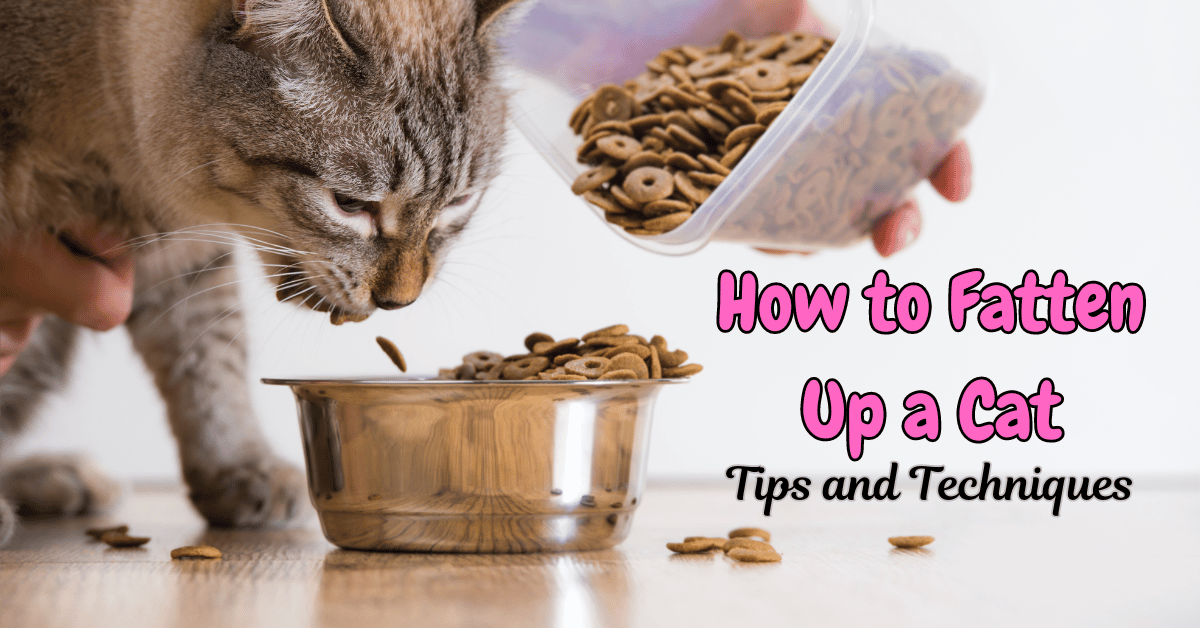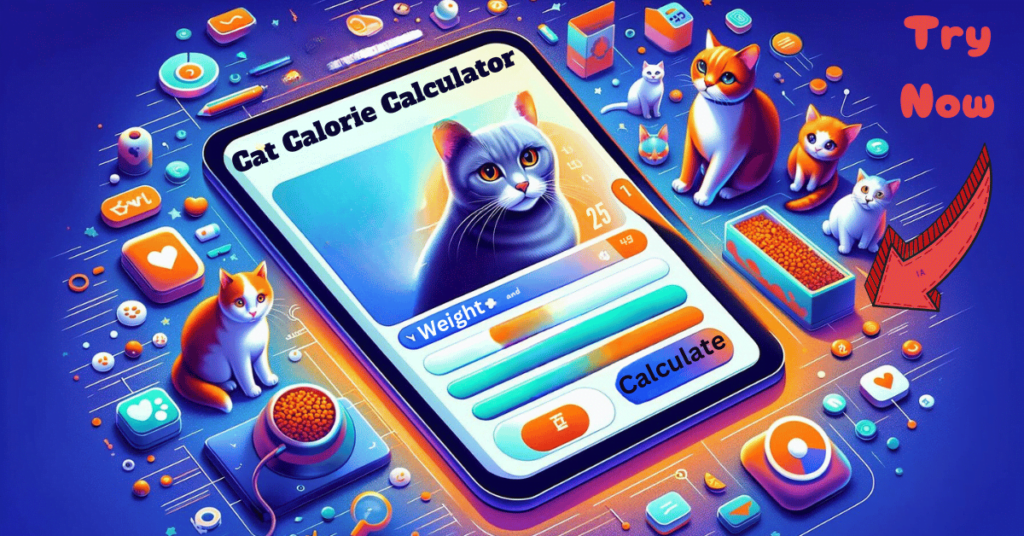This post contains affiliate links and I will be compensated if you make a purchase after clicking on my links.
Fatten Up a Cat: Mastering the Basics of Weight Gain
If your cat is on the skinny side, it’s essential to understand why and how you can help them put on some healthy pounds. There are several reasons why a cat might lose weight, some of which are easily fixable, while others are more serious and potentially life-threatening.
At this stage, since you’re looking for ways to fatten up your cat, we assume you’ve already identified the issue and consulted with a vet. You’ve moved past the diagnostic phase and are ready to help your cat gain weight.
With the serious health concerns ruled out, let’s dive into the strategies that will help your kitty pack on those healthy pounds and get back to their playful, purr-fect self!
Important: Be extremely cautious not to inadvertently transition your underweight cat into an overweight one over time, as this is a common occurrence.
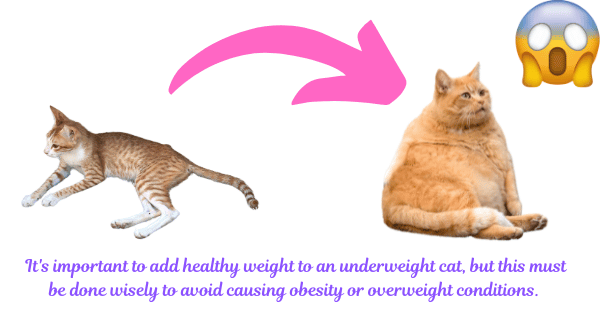
Nutritional and Feeding Strategies to Fatten Up a Cat
1. Adjusting Caloric Intake
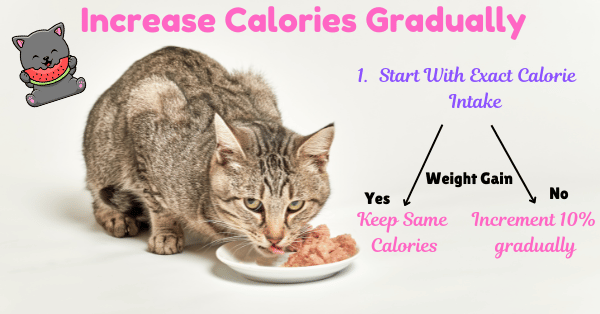
Let’s start with the basics: more calories mean more weight. Weight loss in cats usually occurs when they burn more calories than they take in. This negative caloric balance happens when the body expends or eliminates essential nutrients faster than they are consumed.
Cats in shelters or living as strays often experience malnutrition. If you adopt one of these cats, calorie-dense foods become essential for weight gain. These foods are typically high in fat, providing more calories per gram compared to protein or carbohydrates.
If your cat is consuming sufficient calories but remains underweight, consider gradually increasing their intake by 10-20% increments. Keep track of their consumption to ensure they’re eating enough.
Pro Tip: Baby cat food and kitten food are rich in protein and fat, offering a quick remedy for a high-calorie diet. However, this is only recommended as a temporary solution.
2. Transition to Wet Food
Wet food can be particularly beneficial for underweight cats because it is typically more palatable and easier to eat, especially for cats with dental issues. It also provides additional moisture, which is essential for overall health.
3. Warm Their Food
Many cats have a penchant for warm food, reminiscent of a freshly hunted feast, boasting an irresistible aroma. If your discerning feline snubs their nose at mealtime, consider a straightforward fix: warm up their wet food before serving.
To heat your cat’s meal, simply transfer it to a microwave-safe bowl and warm it for a few seconds. Most cats prefer their food at or near their body temperature, around 38.5°C (101.5°F), for optimal enjoyment.
4. Adding Supplements and Treats
Encourage weight gain by incorporating high-protein treats between meals. Additionally, introduce high-calorie supplements gradually to provide the necessary extra calories for a healthy increase. Remember, always consult with your veterinarian to ensure any supplements are approved, safeguarding your cat’s health and well-being
5. Free Feed Your Cat
Free feeding your cat can be a convenient way to ensure they have access to food whenever they need it. While you can leave food out for your cat throughout the day, it’s essential to keep track of how much they actually consume. Ideally, you should take into account the number of calories you’ve left out during the day to gauge their intake accurately.
6. Serve Multiple Meals
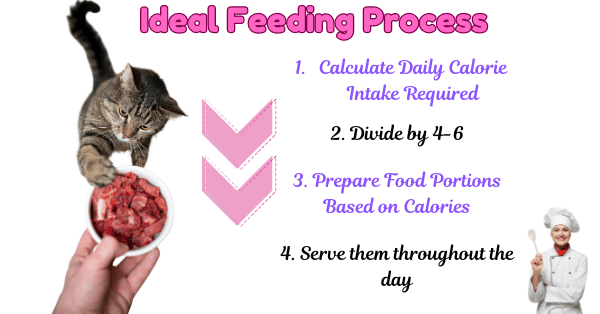
An alternative to free feeding, yet more beneficial, is dividing their daily food into smaller, frequent meals. This ensures a consistent supply throughout the day, which is better tolerated than large meals and reduces the risk of post-meal vomiting. If managing multiple meals manually is challenging, automatic feeders or smart feeders provide a hassle-free solution.
7. Tempting Picky Eaters
Picky eaters can pose a challenge, but with a few strategies, you can tempt even the most discerning feline palate. Change up their food regularly to combat boredom, making the transition gradual by adding a little of the new food at a time.
For extra enticement, try mixing in some tuna or fish oil; if that doesn’t do the trick, add a tiny portion of shredded rotisserie chicken to their food—its irresistible aroma and taste appeal to most cats. Opt for skinless white meat to keep it healthy. Alternatively, many pet stores offer specially-made gravy just for cats, adding an extra flavor boost to their meals.
Pro Tip: Hand feeding your cat can also add a personal touch and encourage them to eat.
8. Use a Feeding Tube
Finally, there are instances when traditional feeding methods may fall short. This is where a feeding tube can make all the difference. This medical device offers a solution for cats who are struggling to consume enough food due to various health issues.
A cat feeding tube serves a vital purpose by delivering a liquid diet directly into the cat’s stomach. This ensures they receive the necessary nutrients for recovery and maintaining their overall health.
Additional Tips for Healthy Weight Gain
Ensuring your cat gains weight in a healthy way involves more than just feeding them more food. Here are some additional tips to support their overall health and well-being.
1. Ensuring Adequate Hydration
Hydration is crucial for all cats, particularly those attempting to gain weight. While wet food can aid in this, ensuring your cat has constant access to fresh water is essential. Cats can be selective about their water intake, so it’s important to cover all bases.
2. Creating a Comfortable Eating Environment
Ensure your cat’s eating area remains serene, devoid of loud disturbances or the presence of other pets, which could disrupt their mealtime peace.
For cats prone to boredom or in need of added encouragement during meals, consider implementing puzzle feeders or slow feeders. These engaging devices not only provide mental stimulation but also promote healthier eating habits by turning mealtime into a fun and interactive activity.
3. Incorporating Gentle Exercise
Opposite to what one might think, incorporating regular, gentle exercise into your cat’s routine can contribute to increasing their muscle mass, facilitating weight gain.
Activities like interactive toys, laser pointers, or utilizing a cat exercise wheel can provide just the right amount of physical activity to promote appetite and support healthy weight gain—a win-win scenario for your furry friend’s fitness journey.
4. Regular Grooming
Though grooming doesn’t directly boost appetite or lead to weight gain, a pampered and well-groomed kitty is more inclined to maintain a healthy weight and appetite. By regularly tidying up their fur, you’re not just keeping them looking their best but also removing any dirt or irritants that could be bothering them.
Putting a Bow on How to Fatten Up a Cat
Embarking on the mission to fatten up your beloved feline companion can truly be a fulfilling endeavor. It’s also crucial to bear in mind that once your cat reaches their ideal weight, the journey doesn’t end there.
Vigilance is key to prevent them from becoming overweight and potentially facing new health issues. Regularly monitor their weight through methods like checking BMI, weighing, or assessing body condition score, and always stay in touch with your veterinarian to ensure your furry friend remains in optimal health.
Meet Sean, a fintech whiz with a penchant for pet purrs and blockchain buzz. After a decade of fintech feats, Sean’s tech talents leaped from ledger lines to litter lines, driven by a passion for pets and a vision for a more connected pet care community. With three critter companions as co-pilots, Sean launched this blog to share a treasury of pet-friendly tech tips and tales.

